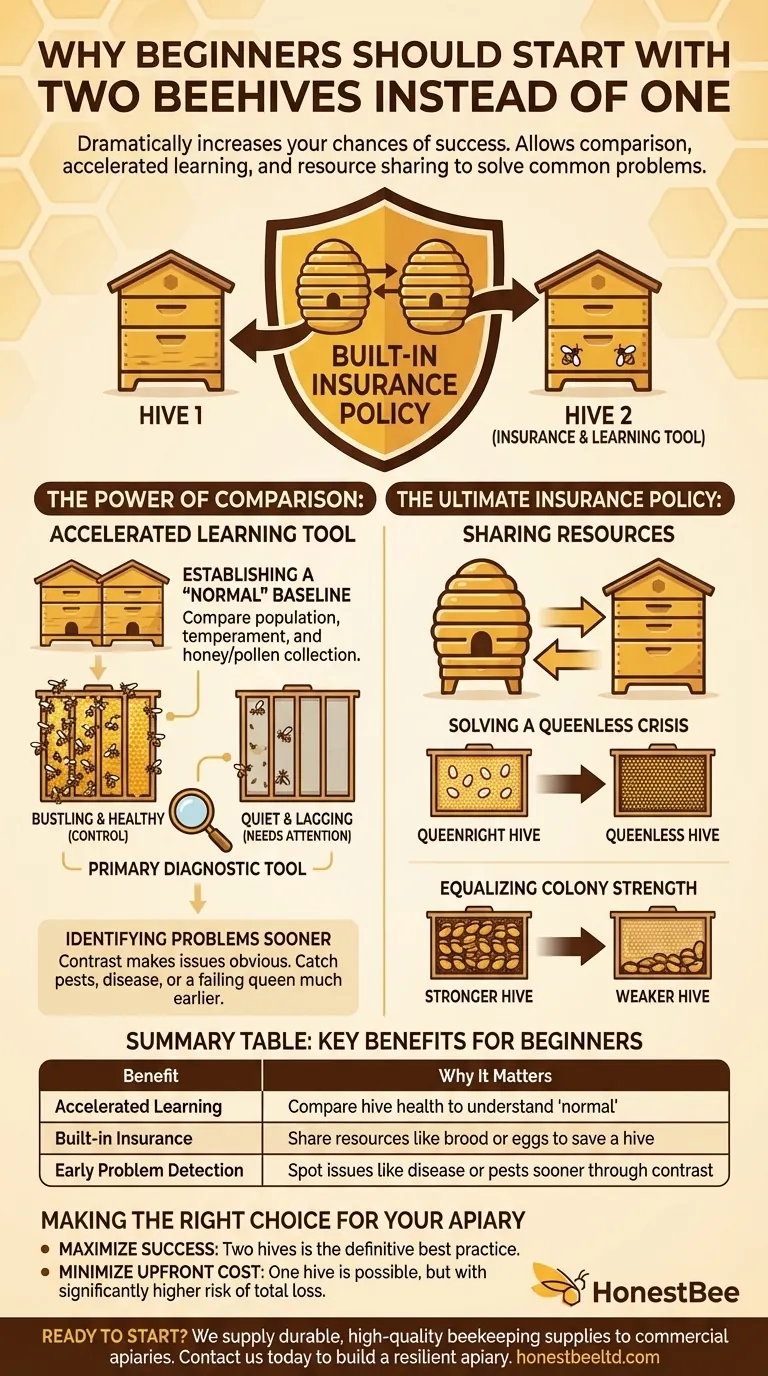Starting with two beehives instead of one is recommended because it dramatically increases your chances of success. It allows you to compare colony development, which accelerates learning, and enables you to share resources between hives to solve common problems—like a lost queen—that would otherwise be fatal to a single colony.
Think of your second hive not as an extra cost, but as a built-in insurance policy and a critical learning tool. The ability to compare and intervene is the single most effective way a beginner can safeguard their investment and their bees.

The Power of Comparison: Your Accelerated Learning Tool
For a new beekeeper, one of the hardest questions to answer is, "Is my hive okay?" Without a point of reference, you have no way of knowing what "normal" looks like.
Establishing a "Normal" Baseline
With two hives side-by-side, you immediately have a control group. You can compare the population size, temperament, and rate of honey and pollen collection between them.
This comparison is your primary diagnostic tool. It quickly teaches you the natural variations in beekeeping and helps you spot when one hive is significantly lagging.
Identifying Problems Sooner
If one hive is bustling with activity and the other is quiet, you have a clear signal to investigate. A single, quiet hive might leave a beginner wondering for weeks, but the contrast between two makes the problem obvious.
This allows you to catch and address critical issues like pests, disease, or a failing queen much earlier than you could with a single, isolated colony.
The Ultimate Insurance Policy: Sharing Resources
The true power of having two hives lies in their ability to support one another. You, as the beekeeper, can act as a manager, moving resources to where they are needed most.
Solving a Queenless Crisis
Losing a queen is a common and serious problem. A hive without a queen is doomed.
If you have a second, healthy hive, you can simply move a frame containing fresh eggs from the queenright hive into the queenless one. The bees in the queenless hive can use one of those eggs to raise a new emergency queen, saving the colony. With only one hive, this option doesn't exist.
Equalizing Colony Strength
It's common for one colony to expand much faster than the other. You can balance this by moving a frame of capped brood (developing bees) from the stronger hive to the weaker one.
This provides a massive population boost to the weaker colony, helping it catch up and increasing its chances of survival and productivity.
Understanding the Trade-offs
While the two-hive strategy is a proven best practice, it's important to acknowledge the practical considerations.
The Initial Investment
Starting with two hives means double the upfront cost for the bees and the hive boxes (brood boxes, supers, frames, etc.). This is the most significant barrier for new beekeepers.
However, many see this as a worthwhile investment when weighed against the high probability of losing a single hive and having to start over from scratch the following year.
The Increased Workload
Managing two hives naturally takes more time than managing one. That said, the added time is minimal once you are already suited up and have your equipment out.
The inspections can be done back-to-back, and the invaluable learning and management opportunities far outweigh the small increase in labor.
Making the Right Choice for Your Apiary
Ultimately, the decision rests on your goals and resources. By understanding the function of the second hive, you can make an informed choice.
- If your primary focus is maximizing success and learning quickly: Starting with two hives is the definitive best practice. The benefits of comparison and resource sharing are invaluable for a beginner.
- If your primary focus is minimizing upfront cost due to a strict budget: You can start with one hive, but you must accept the significantly higher risk of a total loss if the colony encounters a serious issue.
Starting with two hives provides the tools and flexibility you need to overcome challenges, turning potential failures into powerful learning experiences.
Summary Table:
| Benefit | Why It Matters for Beginners |
|---|---|
| Accelerated Learning | Compare hive health and development to quickly understand what 'normal' looks like. |
| Built-in Insurance | Share resources like brood or eggs to save a queenless hive, preventing a total loss. |
| Early Problem Detection | Spot issues like disease or pests sooner by contrasting the activity of two colonies. |
Ready to start your beekeeping journey with confidence?
Starting with two hives is a smart strategy, and having the right equipment is just as important. At HONESTBEE, we supply durable, high-quality beekeeping supplies and equipment to commercial apiaries and distributors through our wholesale-focused operations.
Let us help you build a resilient and successful apiary from the ground up. Contact our team today to discuss your equipment needs and get a quote.
Visual Guide

Related Products
- Professional Galvanized Hive Strap with Secure Locking Buckle for Beekeeping
- Heavy-Duty Nylon Beehive Hive Strap with Stainless Steel Cinch Buckle
- Versatile Ratchet Hive Strap with S-Hooks for Secure Fastening
- Durable Plastic Hive Number Set for Beekeeping
- HONESTBEE Square Top Hive Bee Feeder Top Bee Feeder
People Also Ask
- What are hive straps and why are they used? Secure Your Hives Against Wind, Predators, and Transport
- What is the advantage of using cam buckle straps? Secure Your Load Fast with Simple, Safe Tensioning
- What are the two styles of hive straps? Choose the Right Strap for Your Hive Security
- What are the types of Emlocks available? Choose the Right Strap for Hive Security
- What is the best length for straps used around beehives? Why 12 Feet is the Industry Standard



















